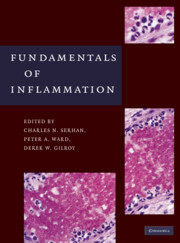Book contents
- Frontmatter
- Contents
- Contributors
- Preface
- PART I THE INFLAMMATORY RESPONSE – AN OVERVIEW
- PART II INDIVIDUAL CELL TYPES
- PART III CHEMICAL MEDIATORS
- PART IV IMMUNOPHARMACOLOGY
- 17 Mediators and Mechanisms of Inflammatory Pain
- 18 Nonsteroidal Anti-Inflammatory Drugs
- 19 Cytokines and Chemokines in Inflammation and Cancer
- PART V INFLAMMATORY DISEASES/HISTOLOGY
- PART VI ANIMAL MODELS OF INFLAMMATION
- Index
- References
19 - Cytokines and Chemokines in Inflammation and Cancer
from PART IV - IMMUNOPHARMACOLOGY
Published online by Cambridge University Press: 05 April 2014
- Frontmatter
- Contents
- Contributors
- Preface
- PART I THE INFLAMMATORY RESPONSE – AN OVERVIEW
- PART II INDIVIDUAL CELL TYPES
- PART III CHEMICAL MEDIATORS
- PART IV IMMUNOPHARMACOLOGY
- 17 Mediators and Mechanisms of Inflammatory Pain
- 18 Nonsteroidal Anti-Inflammatory Drugs
- 19 Cytokines and Chemokines in Inflammation and Cancer
- PART V INFLAMMATORY DISEASES/HISTOLOGY
- PART VI ANIMAL MODELS OF INFLAMMATION
- Index
- References
Summary
Cytokines and chemokines are peptide mediators that regulate a broad range of processes involved in the pathogenesis of inflammatory diseases and cancer. It is well established that an imbalance cytokine or chemokine activities can favor chronic inflammation leading to organ failure. Chemokines and cytokines are also implicated in malignant disease with links to tumor progression, angiogenesis, and invasion. Biological therapies targeting cytokines and chemokines have already improved outcomes of inflammatory disease and clinical trials are ongoing in cancer patients. Targeting tumor necrosis factor (TNF)-α represents a major success story for this approach. Anti-TNF-α was the first antibody against an inflammatory cytokine demonstrated to be efficacious in human disease and it showed over the years to be effective in a range of inflammatory diseases such as rheumatoid arthritis (RA), inflammatory bowel disease (IBD), and more recently, cancer.
CANCER AND INFLAMMATION
The cells and mediators of inflammation also form a major part of the tumor microenvironment. In some cancers, inflammatory conditions precede development of malignancy; in others, oncogenic changes drive a tumor-promoting inflammatory milieu. Whatever its origin, this “smoldering” inflammation aids proliferation and survival of malignant cells, angiogenesis, and metastasis; subverts adaptive immunity, and alters response to hormones and chemotherapeutic agents [1, 2]. The cytokine (Figure 19.1) and chemokine network (Figure 19.2) is of great importance in the processes of cancer-related inflammation regulating both host and malignant cells in the tumor microenvironment [3].
- Type
- Chapter
- Information
- Fundamentals of Inflammation , pp. 244 - 252Publisher: Cambridge University PressPrint publication year: 2010

